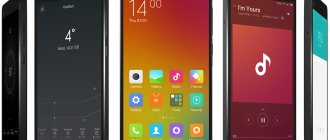What is Motorola Moto G7 Plus?
The Motorola Moto G7 Plus is an affordable smartphone that offers buyers elements of higher-end phones without the hefty price tag. This is an impressive achievement, even compared to today's competitors from Chinese brands such as Xiaomi, Honor and Huawei. Of course, there are better purchases for certain purposes. But it's hard to beat the Motorola Moto G7 Plus because it's a phone you can count on. It's tasteful and well priced.
This is an entry-level phone aimed at the particularly budget-conscious buyer.
Release date and price
The world debut of the newest Moto G7 took place in Sao Paulo, Brazil on February 7. The devices went on sale in two colors: dark blue and ruby red. The devices are available both in regular and online stores, including the official Motorola store. There is also a black version, but it is limited to select regions. At the moment, prices for all G7 models are approximately as follows:
- Moto G7 Play: €150/$170/£130;
- Moto G7: €250/$290/£220;
- Moto G7 Power: €210/$240/£185;
- Moto G7 Plus: €300/$340/£260.
In Russia, Moto G7 Plus can be purchased at a price of 18 thousand rubles and above.
Motorola Moto G7 Plus - Design
The Motorola Moto G7 Plus is the best model in the G series this year, however, its core build hasn't changed much from the 2020 Moto G6 Plus.
Its aluminum sides and glass back are pleasant to the touch and visually appealing. There are much cheaper phones that use a combination of glass and metal, but true curved glass is still relatively rare in phones that don't cost much.
The decoration has changed significantly. The Motorola Moto G7 Plus does not have the same light-reactive finish as the Moto G6 Plus. The dark blue version looks more subdued. You can also purchase in color if you want something bolder.
The red version is perhaps the brightest of the three, but the appearance is spoiled by the circle in the center left by the camera body.
The Moto G7 Plus starts out very similar to the slightly cheaper Moto G7. Plus comes with a little added shine to its finish, with slightly brighter blue lines that appear at certain angles. This is perhaps the thinnest extra charge for an extra £30.
Neither Moto G7 phone is highly water resistant, but the G7 Plus has a P2i water repellent layer that keeps rain out. Most affordable phones don't have official water resistance at all, so even this light protection deserves praise.
The Motorola Moto G7 Plus has a fast fingerprint scanner, 64GB of storage, a 3.5mm headphone jack, and USB-C charging. It even has NFC and an electronic compass, although these may not be present in all variants of the phone, so it's best to check before purchasing.
⇡#Design, ergonomics and software
Motorola, despite all the vicissitudes associated with the brand, which has already been resold a couple of times and has been owned by Lenovo for the last few years, maintains its own style in the design of phones. Motorola moto g7, despite the almost inevitable cutout on the screen these days (in this case, a small “droplet”), stands out noticeably against the general background, and not only with the logo inscribed in the fingerprint scanner.
For a smartphone costing 20 thousand rubles, moto g7 looks unexpectedly thoroughbred - and you can’t explain why exactly. All the signs of the times are in place. The notch has already been mentioned; along with it comes framelessness, and in this case it is truly conditional - the frames around the 19:9 display are very noticeable. The back panel is made of glossy and therefore very slippery glass, curved at the edges, making the gadget seem thinner than it actually is. But both the quality of workmanship and the dual camera module characteristically inscribed in the ring make the moto g7 stand out against the background of the rather faceless, albeit very effective in terms of price and characteristics, Redmi, Zenfone and Honor. However, the latter can also be quite bright – let’s remember Honor 8X.
moto g7, front panel: in the “droplet” is the front camera and sensors, above is the earpiece slot
Motorola moto g7 is offered in two color options - in addition to absolutely black, as in our case, there is also a white version. In terms of its dimensions, this is a typical modern smartphone - two-handed (with the fingers of the same hand with which you are holding the device, it is impossible to reach the corners of the screen; you can print without problems), but easily fits into your pocket. Thanks to the “stretched” display with small frames.
The case is covered on both sides with tempered Gorilla Glass of an unknown version, but I recommend immediately putting it in the included silicone case - it’s very easy to drop such a slippery gadget.
moto g7, the left side is devoid of functional elements
moto g7, right side: power and volume/camera shutter keys
However, even in a case it strives to crawl away from any more or less sloping surface - thanks to those curved edges that create the illusion of thinness. Be careful - Gorilla Glass, of course, increases the survivability of the display in case of falls, but does not guarantee it. This is not a moto Z Force.
moto g7, top edge: microphone and slot for SIM cards and memory cards
moto g7, bottom edge: mono speaker, USB Type-C connector and mini-jack
In terms of layout, moto g7 is almost a traditional Android smartphone. Almost - because the slot for memory cards and SIM cards is located not on the left, but on the top edge, and a mini-jack is found at the bottom. As of 2020, this is still not uncommon, but still a pleasant surprise every time. Full moisture protection is not stated, only splash protection - a couple of drops will not cause the smartphone to fall apart, you don’t have to worry, but dropping it into water is already dangerous.
The fingerprint scanner is capacitive, located on the rear panel. I would like to write “exactly under the index finger,” but this is not so, it is slightly shifted down relative to the natural position of the hand—you have to slightly grab the smartphone. But it is at a considerable distance from the camera block, it is almost impossible to miss and hit the lens with your finger. The sensor works very quickly and stably, no complaints. If desired, you can duplicate it with a facial recognition system - but only the front camera is responsible for it, without additional technical means, so the reliability level of this method is low. You can fool your smartphone with a simple photo; I don’t recommend relying on this unlocking method.
Screenshot gallery
View all images (15)
As I already noted, Motorola’s pride is the “pure” Android operating system, without any shells. In this case it is Android 9.0 Pie. Externally, however, it is slightly different - after all, it couldn’t do without branded themes, widgets and various management features. For example, you can touch the three bottom icons in the traditional way, or you can use gestures instead by swiping your fingers across the display. Do Not Disturb mode turns on if you turn your smartphone face down, and the screen brightness does not change while you are looking at it.
b |
There are other interesting - or not so interesting - functions, all of which can be enabled or configured in a special menu. It's quite possible to do without them, but overall they create a kind of pleasant addition to the experience of using Motorola devices. There is almost no additional software installed, with the exception of a couple of Yandex applications, and there is no second search line - only Google.
Motorola Moto G7 Plus - Screen
The most striking design change this year is the design of the camera on the front of the phone. The strip, which stretches along the entire contour of the phone, bends around the camera located in the center. The result is a kind of drop-shaped notch. Notches like these that slide around the camera lens are typically used to take up as little screen space as possible. The Motorola Moto G7 Plus is surprisingly large in size and the camera looks like a cute eyeball mounted on the edge of the screen.
When Motorola first introduced fingerprint scanners for this series, they were rather awkwardly designed. And now she's done the same with a camera. The wider notch on the G7 Power looks much nicer.
Of course, this all depends on perception. Some people may not notice anything surprising at all. Moto G phones have always had something seductive about their design. This even makes the front of the Motorola Moto G7 Plus much more expressive and recognizable.
Some may not like the Motorola logo at the bottom of the phone's display. But in most cases this is just a waste of emotions.
The screen quality of the Motorola Moto G7 Plus is excellent. The colors are bright, the contrast is sharp enough, and the resolution is high, so anyone who sees pixilation in the fonts is being too picky.
Purists will find the color range limited, and the maximum brightness doesn't compete with phones costing three times as much. Compared to the Honor 8X and Honor Play phones, their screens may be slightly better in some respects. The Motorola Moto G7 Plus has the narrowest, but also the deepest screen notch of all.
You can't go wrong with any of these three phones. But you will have to decide which one to choose, based on your taste and preferences.
The Motorola Moto G7 Plus also has three color modes that let you choose between natural, vibrant, and rich color. This additional choice is welcome.
Related: Best cheap smartphone
Software
The manufacturer claims the purest Android 9 Pie, but few know that there is still a proprietary Moto service on top of it.
To change something in the interface, it is better not to go into the settings, but into a special application. This is exactly how I tried for about 20 minutes to disable the on-screen buttons. The device sensed my desire and gave me a prompt with a link to the above-mentioned application.
It is in this program that various gestures are configured to turn on the camera and flashlight, you can immediately activate the eye-following screen, and here you can control the “In the car” mode.
Along with the device, you are supplied with a couple of services from Yandex in the form of an application and a browser. But I had to install the navigator separately.
In general, I received a positive impression of the firmware. Except for the constantly falling out Bluetooth that couldn't stay paired with the Mi Band 3, causing many important notifications to be missed.
In addition, the fact that even the simplified navigation bar remained visible in all applications was unnerving. And not a transparent one, but a full-fledged strip, in the lower part of which a control strip was hidden.
Motorola Moto G7 Plus - Software
Like other phones in this price range, the Motorola Moto G7 Plus has excellent software. The Moto G Android software is popularly called "vanilla" for its user experience and appearance. To get to the app drawer, you need to swipe up on the screen. The Moto G7 Plus also has a blank translucent white background, like a Google Pixel phone.
In day-to-day use, you experience a smooth and crisp performance that minimizes the difference between the Motorola Moto G7 Plus and a much more expensive handset. It also has the latest Android 9.0.
However, not every part is in place. Android 9.0 introduces Digital Wellness features that let you track app usage and set time limits to prevent overuse. For those who believe that unlimited use of, for example, Twitter and YouTube is not beneficial, but only wastes a lot of time, they can put restrictions on these applications.
Motorola Moto G7 Plus does not have such a feature yet. However, I wouldn't be surprised if Motorola adds them in an update.
Display
The Moto G7 Plus's display has its strengths and weaknesses. The panel itself has no real flaws - vibrant colors, decent brightness levels and decent clarity for its 6.24-inch size. Our observations here are related to the resolution and screen technology, which could have been better in this model.
After releasing so many Plus models, Motorola could have opted for an OLED screen or a slightly higher resolution like 2K (2048 x 1080 pixels). This would have been a more than deserved upgrade to the most expensive variant ever released in the series, but it was probably not adopted to save battery life. Although it must be admitted that the Full HD + format (2270 x 1080) copes with this task perfectly and does not leave much to be desired.
Screen LCD display with FHD+.
Motorola Moto G7 Plus - Performance
The Motorola Moto G7 Plus is one of the members of the 2019 G7 family that does not use the Snapdragon 632 processor. It is equipped with a more powerful Snapdragon 636 processor, just like the Motorola One.
The Geekbench 4 score of the Motorola Moto G7 Plus is almost identical to the Moto G7's score of 4590 to 4691 points. But this does not depend on the difference in GPU.
The Motorola Moto G7 Plus is powered by the Adreno 509 graphics chipset, which is significantly more powerful than the Adreno 506 in the Moto G7. 3D Mark provides an empirical insight into this, as it is a relatively "pure" graphics/games test.
In Slingshot Extreme, the G7 Plus scores 945 points, the G7 512.
Experience shows that the G7 Plus handles high-end games significantly better. These include PUBG, Ark: Survival Evolved and other games that look like console ports.
Unlike the G7, Plus allows you to run Ark with graphics settings higher than "Low", and Asphalt 8 runs more smoothly at high graphics.
However, don't think that the Motorola Moto G7 Plus has a real high-performance processor. This is a mid-range chipset. PUBG, for example, still only allows low graphics. If you want even more performance, choose Honor Play.
The Plus speaker is quite good for a “budget” phone. It only has one driver at the bottom, but the maximum volume and (limited) bass power are well above average. The sound is also more open than that of the Xiaomi Mi 8 Lite.
Performance
The G7 Plus's hardware is no surprise, especially considering the Moto G5S Plus and Moto G6 Plus. We have an octa-core Snapdragon 636 processor with a frequency of 1.8 GHz, 4 GB of RAM and 64 GB of internal memory. Fundamentally, there's nothing special as it's pretty standard hardware to handle all the basic everyday tasks like reading email, gaming, listening to music, streaming video, photo editing and accessing social media.
During our test, we ran a number of games on the phone, including the popular game PUBG. At low resolutions and medium frame rates, we played this game more or less normally. The experience wasn't super smooth, but it didn't affect the gameplay too much.
Although standard, it is quite decent hardware software.
Motorola Moto G7 Plus - Camera
The Motorola Moto G7 Plus has the most impressive hardware in the G7 family. At the back are two cameras led by a 16-megapixel Sony IMX519 sensor and an optically stabilized f/1.75 lens. This is a top brand. You'll find the same sensor in the OnePlus 6.
Motorola has also sped up the camera since the launch of the last generation, making it more fun to use.
Related: Best smartphone
It's not a big upgrade over last year's Moto G6 Plus. Motorola has not included optical image stabilization here. This buffers the camera to allow it to use wider images without blurring. Simply rotating the Motorola Moto G7 Plus in the camera app will give you nice smooth shots.
Night-time image quality is only slightly better than the Moto G7. And even when shooting manually, the maximum exposure time is 1/6 of a second. There's also a surprising amount of smoothed detail visible even when using a low ISO in Manual mode.
The Xiaomi Mi 8 Lite produces much better images by increasing the dynamic range and brightness of dark scenes. There's also no version of the ultra-smart low-light mode that has radically improved nighttime image quality on some phones over the past 18 months.
Phones at this price aren't that smart yet. But the Motorola Moto G7 Plus maintains the quality we saw last year. Hopes for slightly better optical stabilization performance were not justified.
Otherwise, this is a great feature phone and is very competitive in its class. Its automatic HDR is fast and very effective, with good corner sharpness. When handling images, the Moto G7 Plus also tends to show finer detail, although it's also a bit prone to minor purple fringing. The Moto G7's dynamic range tuning is actually better than the Plus's currently, which can result in slightly bright highlights or dull images in high-contrast light situations. I wish Motorola would improve this with an update.
The Moto G7 Plus captures more detail than the Xiaomi Mi 8 Lite, especially in low light. Xiaomi achieved clarity in low-light photos only thanks to more aggressive software improvements.
The Motorola Moto G7 Plus also has an additional 5-megapixel sensor for adding background blur to images. The camera's performance with blur is quite convincing.
Related: Best camera phone
Night photography is quite acceptable for such an affordable phone, but not for OIS
Shooting with background blur Portrait mode
Shooting with background blur Portrait mode
Despite OIS, the G7 Plus's low-light performance is still far from perfect
Like last year's G6 Plus, the new phone can also shoot video at up to 4K resolution at 30fps. At this resolution, it uses optical stabilization to make any hand shake less noticeable. You'll need to drop down to 1080p (30/60fps) to get software stabilization, which eliminates even more motion shake.
The most obvious difference in quality between the G7 and G7 Plus is the selfie camera. Here you get a 12-megapixel front-facing camera with fairly large (for a selfie camera) 1.25-micron pixels. This is the same Omnivision sensor that powers the Moto G7's primary rear camera.
While selfies from the Moto G7 and most other similarly priced phones allow fine details to turn into a blurry mess in low light, the Plus maintains clarity in many frames.
The Moto G7 Plus has one of the best camera setups you can get at this price. And it doesn't just have one good camera sensor, but two. OIS could have been used more effectively, and the lack of attempt at a more aggressive night photography mode is also disappointing. HDR algorithms can also work.
Camera
The main module, in addition to its interesting appearance, also has impressive characteristics. A 16-megapixel lens with f/1.7 aperture is responsible for image quality, and a 5-megapixel sensor with f/2.2 aperture is used for depth sensing.
Portrait mode
The connection turned out to be quite successful. And in the case of a portrait, the device performs no worse than its more expensive counterparts.
When shooting during the day, no problems were identified either. There is fair white balance and good detail. The only thing is that the algorithm is clearly trying to make the frames as sharp as possible, which can result in a grain effect.
At night, the sensor picks up enough light so that you see not just darkness, but the different tones of your surroundings. I am pleased with the work with dark areas; there is no more noise at their boundaries than in the rest of the photo.
The front camera has a resolution of 12 megapixels. And in her case, there is no excessive sharpness. Moreover, in my opinion, it is slightly lacking.
I can only find fault with the post-processing. When you take a photo and want to check it in the gallery, you first see it “soapy”, and then the image is somehow loaded. It's not the most powerful processor that can be blamed for this.
Motorola Moto G7 Plus - Battery Life
Motorola Moto G7 Plus has a 3000 mAh battery. But this is not enough. If you want a phone that lasts an unusually long time on a single charge, the Moto G7 is worth buying.
Motorola's Moto G7 Power has a 5,000 mAh battery, lasts two full days on a charge, and costs less. It's less powerful, the cameras aren't as good, and the screen has a lower resolution.
The Plus is a classic example of "good enough" battery life. Under normal usage, which included a few hours of podcast streaming, some WhatsApp and light browsing, it was left with 30% charge at the end of the first day. And completely discharged around 1 pm the next day.
There's a small chance that the G7 Plus will actually last two days on a single charge for many users. But you should still leave a spare battery in case you need to use your phone more often, for example, when you travel for a long time by train.
The Motorola Moto G7 Plus doesn't have wireless charging like previous years, but it does have a more powerful 27W Turbopower charger. Other phones in the lineup have 18W. It also uses a USB-C to USB-C connector. But this is a big drawback since these cables are much less common (a side effect of the transition from Qualcomm fast charging to PD fast charging).
However, this is handy if you have a new laptop with USB-C connectors instead of the older full-size USB ones. And you can use it to transfer energy from other devices.
Design and appearance
As for design, all new smartphones are presented in the same style, although they have differences. In particular, the initial Moto G7 Play received a body made of textured plastic. The remaining models in the series have more expensive materials, which is very noticeable.
The budget smartphone also has the smallest screen in the line - 5.7 inches compared to 6.2 inches. What's not so good is that the screens of all Moto G7s have a solid frame. I noticed another feature of the line - weak vibration.
The Moto G7 Power features a more durable design with glass on the front and back. This is the largest gadget in the line. The smartphone is slightly wider and longer than the others, and also thicker due to the large battery.
The G7 and G7 Plus look identical and are the most expensive devices in the series. They have very different screens - they don’t have a unibrow, just a teardrop-shaped, less noticeable cutout. The body is covered with glass, the main camera is horizontal and double. It's funny, but I noticed that these cameras are not perfectly aligned.
Is it worth buying the Motorola Moto G7 Plus?
With the new Moto G7 lineup, Motorola hasn't changed its strategy much. Good software, tastefully selected hardware and a price that is also designed for the average buyer.
Compared to the Moto G7, the Plus offers a more dynamic look, more power and a better selfie camera, which is more than enough to justify the extra cost.
Moto G7 Power and Xiaomi Mi 8 Lite are two more interesting alternatives to the tested model. If you treat your phone as a work tool but don't need a better camera, you'll benefit from Power's super-long battery life.
What can we say about Xiaomi Mi 8 Lite? This is another new product that claims to be a leader, and it can be purchased for little money. However, the good and tasteful hardware and software design makes the Moto G7 Plus easy to recommend to almost any buyer.
⇡#Display and sound
The moto g7 has a completely ordinary LCD display - OLED matrices still remain the privilege of flagship devices, unless we are talking about Samsung, of course. Its characteristics are the most standard for a mid-class smartphone: 6.2 inches, Full HD resolution adjusted for 19:9 format (2270 × 1080), pixel density – 403 ppi.
The oleophobic coating here is quite good - you can use the unexpectedly weak one on the Xiaomi Mi 9 as an example. Of course, there is no air gap between the glass and the matrix, but, on the contrary, there is a polarizing coating. The viewing angles are very wide - colors are not distorted when the view is strongly deviated from the perpendicular, only the contrast drops, and even then not too much.
The touch layer responds to 10 simultaneous touches and is moderately sensitive – false clicks and “calling a friend” from your pocket can be avoided. But I didn’t find a mode for working with gloves.
The maximum measured brightness level is 472 cd/m2. Not a record level even for an OLED display, not to mention a liquid crystal matrix. However, the moto g7 does not pretend to play HDR video anyway, and in the sun it is easy and comfortable to read information from its screen even with such indicators.
Contrast is 1224:1, a good average level for an LCD display.
In the display settings you can change the font size or icon scale, as well as select the color rendering mode. Without serious intervention in the RGB scale - just a choice of three presets: natural, bright and saturated. The difference between them is quite arbitrary. I measured the color rendering of the moto g7 display with the "natural colors" and "vivid colors" settings.
moto g7, gamma in “bright colors” mode. Yellow line – moto g7 indicators, dotted line – reference gamma
moto g7, color temperature in “vivid colors” mode. Blue line – moto g7 indicators, dotted line – reference temperature
moto g7, color gamut in “vivid colors” mode. Gray triangle – sRGB coverage, white triangle – moto g7 coverage
By default, the moto g7 display is set to Vivid Color mode. You expect to see an expanded color gamut, increased brightness and, as a rule, cooler shades. If you measure color rendition first in this mode, it seems that this is what you get. The color gamut is indeed slightly expanded, although far from DCI-P3 - here it is rather a slightly “swollen” and shifted sRGB. The average gamut is 2.32, color temperature ranges from 7,500 to 9,000 K. The colors are really cool, but not too cold, the average deviation DeltaE for the extended Color Checker palette (grayscale + a wide range of color shades) is acceptable - 4 .98 with a norm of 3.00. The smartphone can be used with the default display settings – even with a certain level of comfort. And to watch a video with colors close to the original, it’s probably enough to switch to the “natural colors” mode, right?
moto g7, gamma in “natural colors” mode. Yellow line – moto g7 indicators, dotted line – reference gamma
moto g7, color temperature in natural colors mode. Blue line – moto g7 indicators, dotted line – reference temperature
moto g7, color gamut in natural colors mode. Gray triangle – sRGB coverage, white triangle – moto g7 coverage
And no, that's not true at all. The “natural colors” mode is no different from the “bright colors” or “saturated colors” mode in terms of color gamut and, surprisingly, offers color rendition that is further from the standard. The average gamma is about the same - 2.31, the color temperature curve behaves exactly the same, but the average DeltaE deviation according to Color Checker worsens - 5.27. The difference is small, but there is no point in switching between color modes. I wouldn't say that the moto g7's display is poorly configured. The word "strange" is more appropriate.
The moto g7 provides both a mini-jack (3.5 mm) and high-resolution wireless audio transmission (Bluetooth aptX protocol) - you can use almost any headphones with your smartphone without adapters. The sound quality in the headphones is ordinary; the g7 does not have any outstanding musical abilities. The same applies to the external speaker - unlike the older, more expensive and not presented in Russia version of the g7 Plus, there is a mono speaker located on the bottom edge. It is quite loud, but without any frills in sound.
Of the surprises, I would like to note the built-in FM radio receiver - radio as such is still alive, but you can hardly find a receiver in phones anymore. In this regard, moto g7 is a pleasant retro exception.
Calls and quality
I was glad to note that the Moto G line is developing in the right direction. Even despite the lack of VoLTE support, communication with good voice quality. The voice of the interlocutor sounds equally loud only on Moto G7, G7 Plus and G7 Power. And although it is not as clean, rich as on more expensive smartphones, most users will be pleased.
Characteristics
The exact characteristics of the smartphone are still not reliably known today, so the following table is based only on leaks and rumors; its data may change for the worse or for the better. The information below is based only on information from online sources and may be incorrect:
| Options | Characteristics |
| Housing material | Glass with metal inserts |
| Screen | 6.2-inch Full HD+ with Corning Gorilla Glass |
| Resolution and pixel density | 1080×2240, 401 ppi |
| CPU | Qualcomm Snapdragon 660 MSM8956 |
| Number of cores | Octa-core (4x Kryo 260 CPU @ 2.2 GHz + 4x Kryo 260 CPU @ 1.8 GHz) |
| Graphics accelerator | Adreno 512 |
| RAM | 4 GB |
| Built-in memory | 64 GB |
| OS version | Android v8.1 |
| Memory card slot | Yes, dual with SIM slot |
| SIM | 2 nano SIM |
| Main camera | 12 + 5 MP |
| Front-camera | 16 MP |
| Battery | 3500 mAh |
| Sensors | Light sensor, proximity sensor, accelerometer, compass, gyroscope, fingerprint reader |
Screen and sound
The new Moto G7 will likely have a large, high-quality six-inch screen with tempered Corning Gorilla Glass. A resolution of 1080x2240 will provide a high pixel density per inch, and, consequently, a clear, beautiful image.
The purity and quality of the sound produced can only be determined experimentally. Judging by the leaked mockups, the phone will have just one top-mounted speaker. But the Moto G6 showed that one loud speaker is enough, despite the obvious loss of sound quality at high volumes. And for those who like to listen to music the old fashioned way, at the bottom there is a 3.5 mm headphone jack, which manufacturers of top-end flagships are increasingly getting rid of.
Based on the quality of the technology of the previous smartphone model, the sound in the headphones should be good, perfect for inexperienced music lovers. But still, let’s hope that the manufacturer will be able to improve past performance, and this device will outperform its already good brother in sound.
Software
The device will definitely receive one of the latest versions of the system – Android 8.1. (Oreo). On the previous Moto G6 model, the company did not sew its own shell into the phone, so the interface came out almost identical to the standard one. Most of the preinstalled programs are default Google applications, but there are also some of their own utilities. Most likely, the same situation will happen with the Moto G7.
Unfortunately, the company’s original applications and features are not of any interest yet, and many of them want to be replaced with third-party software or disabled. If the situation changes at least somehow in the new smartphone, then this will be great news for those who want to purchase this device.
Performance and autonomy
Like the screen, the processor installed in the phone is currently unknown, but it is highly likely that it will be a device from the Snapdragon family. According to some sources, it will be a Qualcomm Snapdragon 660 with an Adreno 512 graphics accelerator, according to others, a Qualcomm Snapdragon 670 with an Adreno 615 graphics accelerator. You shouldn’t have much hope for the recently introduced 670, but the 660 seems a more likely choice for this price category.
According to some assumptions, Snapdragon 636 may be responsible for the performance of the device, which is also a good choice, because the difference between 636 and 660 is only a small difference in speeds and an improved video adapter. If the forecasts come true, then the phone will be more or less fast in any case. Still, these processors are still quite new and competitive on the market.
But the estimated capacity of the non-removable battery in all sources fluctuates around 3500 mAh. This is a lot, but the device is still unlikely to be enough for a day of active use.
Camera
According to early reports, the plans for the camera of the new phone are quite big. A dual rear camera module of 12 + 5 megapixels, as well as a single front camera module of 16 megapixels should create very good pictures. But the trouble with all more or less budget devices lies precisely in the weakness of the installed photographic equipment, despite the impressive numbers on paper. And as has long been known, the quality of pictures is determined not by the number of pixels, but by their size, as well as aperture ratio and other equally important parameters. Unfortunately, there is no other data on the camera, so it is not possible to judge the quality of the images.
Cost and release date
There is no information yet about either the announcement date or the release date. Some predict the device will appear within the next month, while others expect it to appear at the end of winter. But one thing is certain – the phone should hit the market no later than the second quarter of next year.
Publications specializing in reviews of mobile and other equipment suggest that you will have to pay from 14,500 to 19,000 Russian rubles for the Moto G7. Considering the price of the previous model, most likely the cost of the device will fluctuate around 15-16 thousand rubles, depending on the store. Thus, the new smartphone should be a budget and balanced option for purchase.
Motorola Moto G7











